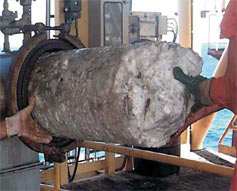
Handy Links
SLAC News Center
SLAC Today
- Subscribe
- Archives: Feb 2006-May 20, 2011
- Archives: May 23, 2011 and later
- Submit Feedback or Story Ideas
- About SLAC Today
SLAC News
Lab News
- Interactions
- Lightsources.org
- ILC NewsLine
- Int'l Science Grid This Week
- Fermilab Today
- Berkeley Lab News
- @brookhaven TODAY
- DOE Pulse
- CERN Courier
- DESY inForm
- US / LHC
SLAC Links
- Emergency
- Safety
- Policy Repository
- Site Entry Form

- Site Maps
- M & O Review
- Computing Status & Calendar
- SLAC Colloquium
- SLACspeak
- SLACspace
- SLAC Logo
- Café Menu
- Flea Market
- Web E-mail
- Marguerite Shuttle
- Discount Commuter Passes
-
Award Reporting Form
- SPIRES
- SciDoc
- Activity Groups
- Library
Stanford
Around the Bay
Under Pressure
 Wendy Mao uses gem-quality diamonds as vise grips to put materials under severe pressure while exposed to brilliant x-ray beams.
Wendy Mao uses gem-quality diamonds as vise grips to put materials under severe pressure while exposed to brilliant x-ray beams.
In this way she can learn how materials change during extreme conditions, allowing scientists to probe materials near the center of Earth while also looking for new energy-related materials.
"The diamonds are transparent to x-rays, so you can probe the sample at high pressure," said Mao, who is a new assistant professor, jointly appointed in SLAC's Photon Science Department and Stanford's Department of Geological and Environmental Sciences. Mao is also a principal investigator at SLAC's X-Ray Laboratory for Advanced Materials (XLAM).
One of the intriguing materials she studies is a collection of polyhedral ice cages made of water molecules, which are stable when guest molecules occupy the cages. Called clathrates, these full cages occur naturally on the ocean floor and in permafrost regions, where there are low temperatures, high pressures, or both. Clathrates can form in gas pipelines on the ocean floor, causing major economic and safety headaches.
The ice cages can also contain clusters of hydrogen gas molecules (H2), making them a potentially clean and cheap way to store hydrogen for fueling cars in the future. Imagine popping an ice cube into your gas tank. Melting, it releases hydrogen for fuel and leaves only water for exhaust.
Before that day arrives, however, researchers need to figure out how to pack more hydrogen into clathrates and other molecular compounds, as well as how to synthesize and store these materials at more practical conditions. Currently, it takes 2 kilobars, or 2,000 times the pressure on the surface of the Earth, to make hydrogen clathrates. Mao did discover a hydrogen clathrate phase at moderate pressure, but it doesn't store as much hydrogen as desired.
She is also investigating hydrogen-methane compounds, one of which stores over 33 percent H2 by weight—at high pressures and low temperatures. The goal is to understand how H2 is stored in specific structures within compounds. With this knowledge, researchers may be able to engineer chemical pathways that will allow efficient hydrogen storage at practical conditions.
"Our approach is to explore a large range in pressure, temperature and composition in search of material phases with high storage capacity. We then need to find a way to bring these structures close to ambient conditions. Along the way, we also hope to increase our understanding of how molecular hydrogen bonds with potential hosts," Mao said.
Mao's XLAM work is supported by a Department of Energy grant.
—Heather Rock Woods, SLAC Today, November 29, 2007
Above image: Naturally occurring materials called clathrates can clog offshore gas pipelines, as shown above, but one day researchers may be able to engineer them to store enough hydrogen to fuel cars. (Image courtesy of Petrobras.)